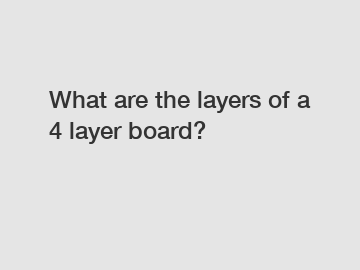What are the layers of a 4 layer board?
As technology continues to advance at a rapid pace, circuit boards have become an integral part of countless electronic devices. One common type of circuit board is the 4-layer board, which consists of four distinct layers that work together to support the functionality of the device. In this blog post, we will explore the layers of a 4-layer board in depth, explaining their purposes and how they contribute to the overall functionality of the device.
The first layer of a 4-layer board is known as the signal layer. This layer is responsible for carrying the electrical signals between the various components of the device. The signal layer is typically made of copper traces that are etched onto the board, providing a pathway for the signals to travel. These traces must be carefully laid out to ensure that the signals reach their intended destinations without interference from other components or signals. The signal layer plays a crucial role in ensuring the proper functioning of the device, as any disruptions or errors in the signal flow can lead to malfunctions or complete device failure.
The second layer of a 4-layer board is the power plane layer. This layer is responsible for distributing power throughout the device, providing the necessary voltage and current to keep the components functioning properly. The power plane layer typically consists of a solid sheet of copper that is connected to the power source of the device. This layer helps to regulate the power distribution, ensuring that each component receives the appropriate amount of power to operate efficiently. The power plane layer is essential for maintaining the stability and reliability of the device, as fluctuations in power supply can lead to damage or malfunction of the components.

The third layer of a 4-layer board is the ground plane layer. This layer is responsible for providing a stable ground connection for the components of the device. The ground plane layer is typically made of a solid sheet of copper that is connected to the ground of the device. This layer helps to reduce electromagnetic interference and noise, ensuring that the signals transmitted through the signal layer remain clear and accurate. The ground plane layer plays a crucial role in maintaining the overall integrity and performance of the device, as a poor ground connection can lead to signal distortions and malfunctions.
The fourth and final layer of a 4-layer board is the solder mask layer. This layer is responsible for protecting the board from environmental factors, such as moisture, dust, and debris. The solder mask layer is typically made of a thin layer of polymer that is applied over the copper traces and components of the board. This layer helps to prevent corrosion and damage to the board, ensuring its longevity and reliability. In addition to protection, the solder mask layer also helps to insulate the components and prevent short circuits that can occur if the traces come into contact with each other.
In conclusion, the layers of a 4-layer board work together to support the functionality and reliability of electronic devices. The signal layer carries electrical signals between components, the power plane layer distributes power, the ground plane layer provides a stable ground connection, and the solder mask layer protects the board from environmental factors. By understanding the purpose and significance of each layer, designers and engineers can create circuit boards that are efficient, reliable, and high-performing. As technology continues to evolve, the importance of 4-layer boards in electronic devices will only continue to grow, making it essential to have a thorough understanding of their layers and their roles in device functionality.
For more immersion tin pcb , consumer electronics pcb , Lead Free HASL PCB information, please contact us. We will provide professional answers.
109
0
0


Comments
All Comments (0)